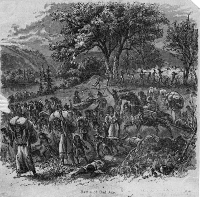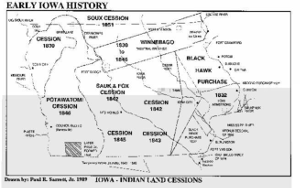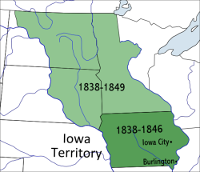The Making of the 50 States: Iowa
Part 2: The Rest of the Story When Congress approved the Missouri Compromise in 1820, it set a line of latitude above which territories would not have slavery. What is now Iowa was at this time part of an unorganized territory. Iowa was then part of the Michigan and then the Wisconsin Territory. 
The Black Hawk War in 1832 pitted Native Americans led by Sauk leader Black Hawk against members of an American militia. The Americans were victorious, further accelerating the departure of Native Americans from Iowa and from other nearby lands. A series of Cessions marked the migrations of tribe after tribe. Fort Atkinson was built as part of this ongoing series of events (although it was built in part to offer protection for the Winnebago for a time); also established, in the 1832, was the United States Department of Indian Affairs. 
Resulting from the end of the Black Hawk War was the 1833 Black Hawk Cession, a surrendering of a large amount of land from Native Americans to Americans; as a result, settlement in Iowa accelerated, with settlers coming primarily from Indiana, Kentucky, New York, Ohio, Pennsylvania, and Virginia. Some used to living in wooden houses had to settle in to sod houses instead because of a relative lack of wood; as well, some settlers constructed fences out of stone. The Panic of 1837 caused the failure of Iowa's only bank and stalled the area's economic momentum for a time; however, the recovery was relatively swift. 
Congress created the Iowa Territory in 1838; the first territorial capital was Burlington. In this territory were about 194,000 square miles of land, including all of what is now the State of Iowa, the western part of what is now the State of Minnesota, and parts of North Dakota and South Dakota. In 1844, the territory's Legislative Assembly called for a vote on a constitution convention. The population supported such an idea, and the convention met in Iowa City, by then the territorial capital, to draft a constitution. When the U.S. Congress passed a bill providing for Iowa statehood in 1845, the boundaries were different from those the Iowa people had approved. Some further negotiations ensued, and it was several months before it was all ironed out, with Iowans approving the boundaries as changed by Congress. 
Iowa had to wait awhile as well because the U.S. Congress at the time was obsessed in keeping the balance between states that allowed slavery and states that didn't. Because Iowa was above the geographical line set out by the Missouri Compromise, it was a "free" state" and so would have to wait for a "slave" state to apply for admittance into the Union. That state was Florida, which became a state in 1945. Iowa became a state on Dec. 28, 1846. The capital was Iowa City. First page > In the Beginning > Page 1, 2
|
|
Social Studies for Kids
copyright 2002–2026
David White




